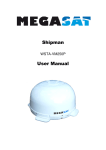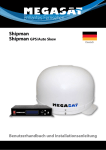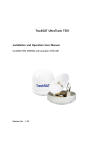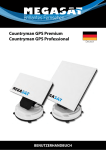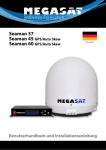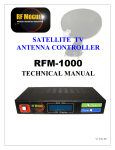Download Megasat WSTA-VM250P User manual
Transcript
Shipman WSTA-VM250P Bedienungsanleitung Achtung! Bitte lesen Sie diese Bedienungsanleitung, bevor Sie die Antenne installieren und in Betrieb nehmen, um Fehler bei der Montage und Handhabung zu vermeiden. Die Megasat VM250P ist eine automatische, selbst ausrichtende und nachführende Satellitenantenne für die Satelliten Astra 1 (19,2°O), Eutelsat/Hotbird (13°O), Astra2 (28,2°O), Astra3 (23,5°O), Astra4/Sirius (4,8°O), Thor5/6 (0,8°W), Hispasat (30°W) und Türksat (42°O). Diese digitale Antenne ist somit die ideale Empfangslösung für Wohnmobil, Bus, LKW, Schiff und PKW. Das Nachführungssystem ermöglicht auch Fernsehempfang während der Fahrt. Die Antenne ist einfach zu montieren, sie wird mit einem Spezialkleber auf das Dach aufgeklebt oder mit Schrauben befestigt. Es führt nur ein Anschlusskabel zur Antenne. Der kompakte Aufbau in Kuppelform und die niedrige Aufbauhöhe von ca. 40cm machen diese Antenne absolut unempfindlich gegenüber Wind und muss nicht währen der Fahrt abgebaut oder eingeklappt werden. 1. Lieferumfang − − − − Kuppel-Antenne VM250P Steuergerät inkl. Stromversorgungskabel Antennenanschlusskabel Schutzkappe für F-Stecker Spezialklebeset inkl. Reiniger mit Primer und Applikator 2. Montage Grundsätzlich empfehlen wir, den Einbau durch Ihren Fachhändler oder eine Fachwerkstatt vornehmen zu lassen! Beachten Sie bitte auch, dass sich durch die Antenne die Fahrzeughöhe entsprechend ändert! Wichtig! Bitte halten Sie sich unbedingt an die einzelnen Punkte der Montageanweisung! Beachten Sie bitte auch unsere Gewährleistungshinweise! Allgemeines: Sorgen Sie für einen geeigneten Arbeitsplatz, eine Garage/Halle ist besser als ein Platz im Freien. Die Umgebungstemperatur zur Montage soll zwischen +5°C und max.+25°C liegen. Arbeiten Sie im Freien nicht in der Sonne. Halten Sie die Arbeitsvorschriften beim Umgang mit Chemieprodukten ein. Sorgen Sie für die notwendige Arbeitshygiene. Vorbereitung: 1. Vergewissern Sie sich, dass das Dach Ihres Fahrzeugs ausreichend stabil ist. Bei ungenügender oder zweifelhafter Dachstabilität ist ein ca. 2mm starkes Blech mit ca. 100 x 100 cm auf der Dachaußenhaut zu befestigen. Erkundigen Sie sich dazu bei Ihrem Fahrzeughersteller. Weiter Information finden Sie im Anhang unter „Verarbeitungshinweise“ 2. Prüfen Sie, ob alle Teile vorhanden sind 3. Setzen Sie die Antenne auf den späteren Einbauplatz und richten Sie sie aus. Achten Sie darauf, dass der Einbauplatz eben ist und keine Dachaufbauten im Weg sind, die den Satellitenempfang stören können. Aufbauten bis zu 8cm Höhe spielen keine Rolle, höhere Aufbauten sollten einen entsprechender Abstand zur Antenne haben, damit kein Hindernis zwischen Antenne und Satellit (minimale Elevation 16°-17°) vorhanden ist . Der min. Abstand zu einer Klimaanlage sollte 30cm betragen. Achtung! Zeichnen Sie die Antennenfüße mit einem geeigneten Stift an. 4. Suchen Sie eine geeignete Stelle (im Windschatten im hinter der Antenne) im Fahrzeugdach für die Durchführungsbohrungen der Anschlusskabel. Achten Sie darauf, dass die Kabel nicht zu sehr gebogen werden (minimaler Biegeradius ca. 5-7cm). Bohren Sie die Löcher vorsichtig in das Fahrzeugdach. 5. Entfernen Sie die Antenne wieder. Reinigen Sie die Montagefläche und die Antennenfüße mit einem Reiniger und einem Vliestuch (Latexhandschuhe tragen). Schleifen Sie die Flächen und Füße mit 120er Schleifpapier leicht an und reinigen Sie erneut mit dem Reiniger (ACHTUNG: Flächen anschließend nicht mehr berühren) und lassen Sie den Reinigen ca. 10 Minuten ablüften. Hinweis: Sollte die Klebefläche aus einem Ihnen unbekannten Material bestehen, empfehlen wir dringend, eine Probeklebung vorzunehmen. Wir sind selbstverständlich in Zusammenarbeit mit unserem Lieferanten in der Lage, eine Materialanalyse durchzuführen, dies ist aber mit nicht unerheblichen Kosten und Zeitaufwand verbunden. Klebung: 1. Schneiden Sie die Kartusche mit dem Spezialkleber auf (Latexhandschuhe tragen) und setzen Sie die schräg angeschnittene Kartuschenspitze auf. 2. Tragen Sie nun den Kleber auf die Klebeseite der Antennenfüße gleichmäßig auf, so dass eine mindestens 3-4 mm dicke Klebeschicht entsteht. 3. Setzen Sie nun sofort (max. innerhalb von 5 Minuten nach Kleberauftrag) die Antenne auf die angezeichneten Felder. Drücken Sie die Füße leicht und gleichmäßig an und fixieren Sie die Antenne gegen Verrutschen, z.B. durch Klebeband. Es müssen sich nach dem Andrücken noch mindestens 2mm Kleber zwischen Antennenfuß und Oberfläche befinden. Die Aushärtung des Klebers beträgt maximal 48 Stunden bei +18°C und einer relativen Luftfeuchte von 50%. Sollte während der Montagezeit sehr wenig Luftfeuchtigkeit herrschen, sprühen Sie nach dem Aufsetzen der Antenne mit einem Sprüher etwas Wasser in die Luft im dem Bereich der Antennenfüße. 4. Entfernen Sie die ausgetretene Klebemasse sofort mit einem Holzspatel und wischen Sie verunreinigte Flächen mit einem Wischvliestuch und Reiniger sauber. 5. Zu Ihrer Sicherheit können Sie die Antennenfüße mit je einer Schraube durch die vorhandene Bohrung auf der Oberfläche zusätzlich sichern (empfohlen). Setzen Sie die Schraube erst nach dem Aushärten des Klebers. 6. Bitte beachten Sie, dass noch etwas Kleber für die Durchführung der Kabel benötigt wird. 3. Anschluss Montieren Sie die Steuerbox und den Satellitenreceiver im Fahrzeuginneren nicht im Bereich eines Airbags! Achten Sie auf eine sorgfältige Verlegung der Kabel, um Kurzschlüsse zu vermeiden! Achten Sie hierbei auch auf schon vorhandene Kabel! 1. Schließen Sie die Antenne mit dem beiliegenden Koaxialkabel an der Steuerbox an. 2. Setzen Sie anschließend die Schutzkappe über die Anschlussbuchse der Antenne (Schutz vor Witterungseinflüssen). 3. Verbinden Sie das Stromversorgungskabel mit der Box und der Stromquelle (z.B. Fahrzeugbatterie). Das rote Kabel ist der Pluspol (+), das schwarze der Minuspol (-). ACHTUNG: Schließen Sie das Gerät immer über eine abgesicherte Leitung an (niemals direkt an die Auto Batterie) Anschluss für Receiver Anschluss für Antenne SD Memory Card Slot SD_CARD Steuerbox (Rückseite) Stromversorgung 12V5A RS-232 RECEIVER ANTENNA 12VDC 12VDC IN OUT 4. Schließen Sie den Satellitenreceiver gemäß der entsprechenden Bedienungsanleitung an und verbinden Sie ihn nun mit dem kurzen KoaxialZwischenkabel mit der Steuerbox. Systemkomponenten Antenneneinheit Unter der außen Einheit (Kuppel) befindet sich eine 45cm Hochleistungsantenne. Die elegante Kunstoffhaube schütz die Antenne bestens gegen äußere Witterungseinflüsse. IDU (Steuergerät) Mit der IDU wird das Antennensystem gesteuert und mit Strom über das Antennenkabel versorgt. Das Steuergerät wird zwischen Antenne und Receiver geschaltet und wird nur zur Satellitenwahl und Ausrichtung benötigt. Nach erfolgreicher Ausrichtung kann das Gerät ausgeschaltet werden. Bei Benutzung währen der Fahrt, wird das Steuergerät zur Nachführung benötigt und darf nicht abgeschaltet werden. Anschluss Montieren Sie die Steuerbox und den Satellitenreceiver im Fahrzeuginneren nicht im Bereich eines Airbags! Achten Sie auf eine sorgfältige Verlegung der Kabel, um Kurzschlüsse zu vermeiden! Achten Sie hierbei auch auf schon vorhandene Kabel! Antenne Antenne 12VDC~24VDC oder Netzteil 230VAC/12VDC 5A Satelliten Receiver Receiver TV 4. Inbetriebnahme und Bedienung 1. Schalten Sie den Monitor/TV-Gerät und den Satellitenreceiver ein. 2. Schalten Sie die Steuerbox ein. Die IDU Überprüft die Kommunikation zur Außeneinheit und die Anzeige des voreingestellten Satelliten wird im Display angezeigt. Nun startet der Suchvorgang. 3. Wenn die VM250P einen Satelliten gefunden hat, stoppt sie und führt eine Feinabstimmung durch. Danach leuchtet die Lock-Anzeige im Display auf und das Bild erscheint auf Ihrem Monitor (falls Sie an Ihrem Satellitenreceiver einen Sender im High-Band mit vertikaler Polarisation, z.B. PRO7 oder SAT1 eingestellt haben, erscheint das Bild bereits während der Feinabstimmung). Im stehenden Betrieb geht die Steuereinheit in den Stromsparmodus. Bei Betrieb während der Fahrt bleibt das Gerät in Bereitschaft. Der erstmalige Suchvorgang kann bis zu 5 Minuten dauern. Nach einem Standortwechsel ist dieser Vorgang oftmals wesentlich kürzer, da die vorige Position (Elevation) in der Steuerbox abgespeichert wurde. 4. Wenn Sie auf einen anderen Satelliten wechseln wollen, drücken Sie die Satelliten Auswahltaste so oft bis der gewünschte Satellit im Display Anzeigt wird. Nun wechselt die Antenne auf den neuen Satelliten. ASTRA 2 Wählen Sie diese Einstellung für Astra2 auf 28,2° Ost. ASTRA 3 Wählen Sie diese Einstellung für Astra 3 auf 23,5° Ost. ASTRA 1 Wählen Sie diese Einstellung für Astra 1 auf 19,2° Ost. HOTBIRD Wählen Sie diese Einstellung für Hotbird 13° Ost. ASTRA4 Wählen Sie diese Einstellung für Astra4/Sirius auf 4,8° Ost. THOR Wählen Sie diese Einstellung für Thor 0,8° West. HISPASAT Wählen Sie diese Einstellung für Hispasat auf 30° West. TÜRKSAT Wählen Sie diese Einstellung für Türksat 42° Ost. Achten Sie darauf dass die gewünschte Satellitenrichtung freie Sicht zum Himmel hat. (Orbit Position des Satelliten) schlechter oder kein Empfang guter Empfang Die Antenne wurde dafür entworfen, so effizient und so zuverlässig als möglich zu arbeiten. Wenn die Antenne den ausgewählten Satelliten gefunden hat und die Feinabstimmung beendet ist, geht das Steuergerät in den Standby Betrieb. Jetzt können Sie die IDU ausschalten um unnötigen Stromverbrauch zu vermeiden. Die Versorgung der Satellitenanlage erfolgt durch den Receiver und wird durch die IDU geschliffen. Bei fahrendem Betrieb, darf die IDU nicht abgeschaltet werden. Funktion LCD Display Power S/W ON OFF LCD Display MEGASAT Drücken bis die gewünschte Satellitenanzeige leuchtet. SATELLITE SELECT SLEEP POWER Standby Erklärung der LCD Anzeige - INIT : Initialisierung der Antenne. - INIT-SCH : Anfangssuchmodus. - SAT-MOVE: Wechselt zu einem anderen Satelliten. - S:xxx : Intensität des Signala. - ID:xxx : ID des Satelliten. - GYRO-CAL : Kalibrierung Gyro Sensor. Allgemein ON OFF Gerät Einschalten. POWER Information der IDU. Information of IDU Drücken der Satellitenauswahltaste SATELLITE SELECT Bis der gewünscht Satellit angezeigt wird. ASTRA1 IDU startet. START !!! ASTRA1 Die Antenne wird initialisiert. INIT ASTRA1 GYROGYRO- Gyroskopsensor wird kalibriert. CAL ASTRA1 SEARCH… SEARCH ASTRA1 ID : AS1 AS1 Die Antenne sucht den gewählten Satelliten. ID und Signalstärke des Satelliten werden TRACKING S : 288 überprüft. ASTRA1 Die Antenne stoppt und übernimmt den Satelliten. ID : AS1 AS1 AUTOAUTO-SLP S : 288 Im Falle einer fehlerhaften Suche Die Antenne sucht den gewünschten Satelliten. ASTRA1 SEARCH… SEARCH Wenn der Satellit innerhalb von 2 Minuten nicht gefunden wird, beginnt die Suche von vorne.. ASTRA1 INITINIT-SLP ASTRA1 Die Antenne sucht den gewünschten Satelliten. SEARCH… SEARCH ASTRA1 ID : AS1 ID und Signalstärke des Satelliten werden TRACKING S : 288 überprüft. ASTRA1 Die Antenne stoppt und übernimmt den Satelliten. ID : AS1 AUTOAUTO-SLP S : 288 6. Falls es Probleme gibt • • • • • • • Sind Hindernisse (Bäume Gebäude usw.) in Richtung des Satelliten? Wählen Sie einen anderen Standort. Sind Gebäude in unmittelbarer Nähe kann es zu Reflektionen kommen und die Antenne richtet sich nicht korrekt aus (Standort wechseln) Sind die Antennenkabel korrekt angeschlossen oder defekt (Kabelbruch)? Überprüfen Sie die Antennenstecker und Anschlusskabel. Haben Sie den richtigen Satelliten angewählt? Prüfen Sie, ob der im Receiver eingestellte Satellit mit dem in der Steuerbox angewählten übereinstimmt. Ist die Steuerbox/Sat-Receiver eingeschaltet? Ist die Stromversorgung angeschlossen? Kontrollieren sie die Anschlusskabel. Skew Einstellung anpassen. (siehe Tabelle) Je nach Standort kann es erforderlich sein den Skew entsprechend Ihrer Position nachzustellen. Europa Position - Raster Bitte entnehmen Sie der Tabelle Ihre Postion (1-25) Die Skew Anpassung (LNB Winkel), finden Sie in der Liste (Skew Anpassung) . Skew Anpassung Um die korrekte Skew Einstellung vorzunehmen, entfernen Sie die Kuppel der Antenne und lösen beide Schrauben der LNB Halterung so weit, dass das LNB sich drehen lässt. Bewegen Sie jetzt das LNB entsprechend der Tabelle auf die richtige Position und befestigen Sie die Schrauben der LNB Halterung. Anschließend schließen Sie die Kuppel wieder. Hinweis: Diese Einstellung müssen Sie nur einmalig bei größeren Abweichungen vornehmen. Rast er Pos. 1 2 3 4 5 6 7 8 9 10 11 12 13 14 15 16 17 18 19 20 21 22 23 24 25 ASTRA2 N 28.2°E ASTRA2 S 28.2°E ASTRA3 23.5°E ASTRA1 19.2°E HOTBI RD 13.0°E ASTRA4 4.8°E THOR 0.8°W HISPAS AT 30°W TURKS AT 42°E 13° 10° 6° 1° -2° 17° 13° 8° 2° -3° 21° 17° 10° 2° -4° 27° 21° 12° 3° -5° 33° 26° 16° 4° -6° 13° 10° 6° 1° -2° 17° 13° 8° 2° -3° 21° 17° 10° 2° -4° 27° 21° 12° 3° -5° 33° 26° 16° 4° -6° 11° 8° 4° -1° -4° 14° 10° 5° -1° -6° 18° 13° 6° -1° -7° 23° 17° 8° -2° -9° 29° 21° 10° -2° -11° 10° 6° 2° -3° -6° 12° 8° 2° -3° -8° 16° 10° 3° -4° -10° 20° 14° 4° -6° -13° 25° 17° 5° -7° -16° 7° 4° -1° -5° -9° 9° 5° -1° -7° -11° 12° 6° -2° -9° -14° 15° 8° -2° -11° -18° 19° 10° -2° -14° -23° 3° 0° -4° -9° -12° 4° 0° -6° -11° -15° 6° 0° -7° -15° -20° 8° 0° -10° -18° -25° 9° 0° -12° -23° -30° 1° -3° -7° -11° -14° 1° -3° -9° -14° -18° 2° -4° -11° -18° -23° 2° -6° -15° -23° -28° 3° -7° -18° -28° -34° -11° -14° -18° -20° -22° -15° -18° -22° -25° -27° -19° -23° -28° -32° -34° -23° -29° -34° -38° -41° -29° -35° -41° -45° -48° -11° -14° -18° -20° -22° -15° -18° -22° -25° -27° -19° -23° -28° -32° -34° -23° -29° -34° -38° -41° -29° -35° -41° -45° -48° LNB Center Line (-) Direction Satelliten Signal (+) Direction LNB Signal Die Signale Vertikal (rot) und Horizontal (blau) werden in einem genauen Winkel von 90° gesendet. Die Signale des Satelliten werden im selben Kreuzmuster gesendet. Um einen optimalen Empfang zu erreichen müssen beide Elemente im gleichen Winkel zueinander stehen. Je genauer die Übereinstimmung desto besser der Empfang. Diese Einstellung nennt man Skew Einstellung. Da sich diese Einstellung entsprechend Ihrem Standort ändert (siehe Tabelle), muss der Skew um eine optimale Ausrichtung zu erreichen Angepasst werden. Systeme mit automatischer Skew Einstellung führen das LNB selbständig nach. Bei manuellen Systemen, muss das per Hand vorgenommen werden. Bad Good Best : LNB “Signal collector” : Satellite Signal LNB Center Line (-) Direction (+) Direction Skew Anpassung 7. Technische Daten Frequenzbereich: LNB-Typ: 10,7 bis 12,75 GHz LNB Typ: Universal Polarisation: horizontal und vertikal Gain/Verstärkung: 33dBi Elevation (Neigung): 17° 60° Suchwinkel (Azimut): 360° Stromversorgung: 12-24V / 5A Temperaturbereich: -22°C bis +55° C Antennenkabel: Koaxialkabel 100dB (10m) Durchmesser: ca. 68cm Höhe: ca. 40cm Gewicht: ca. 9kg (ohne Steuerbox): Megasat Industriestrasse 4a D- 97618 Niederlauer Tel. +49 (0) 9776 63567-100 Fax. +49 (0) 9776 63567-144 www.megasat.tv Verarbeitungshinweise Shipman WSTA-VM250P User Manual 1 Introduction Specification………………….……………………………………………………. Antenna System Overview……………………………………………………. Direct Broadcast Satellite Overview………………………….………….. System Components…………………………………………………………… 2 Installation Unpacking the Unit………………………………..……………………....... Preparing for the installation………………………………………………. Selecting the location………….……………………………………….……... Equipment and cable installation…………..……………………………. Setting the LNB Skew Angle(Manual Skew version only)……….. 3 Operation Receiving Satellite TV Signals…………….………………………………. Turning the System On/Off…………..………………..………………….. Changing Channels………………………….…………………...…..……….. Watching TV…………………………………………………………..……..….. Switching between Satellites……………………………………………….. Operating the IDU……………………………………….………………….. 4 Troubleshooting Simple Check……………………………………………..…………………. Causes and Remedies……………………………….……..………………. 1 Appendix A How to set the skew angle……………………………………………..……. 2 Appendix B Satellite Coverage Map…………………..………………………..……. 3 Appendix C Firmware Upgrade…………………….…………………………………. 4 Appendix D Antenna Drawing …………………….…………………………………. Notes, Cautions, and Warnnings Caution – Improper handling by unqualified personnel can cause serious damage to this equipment. Unqualified personnel who tamper with this equipment may be held liable for any resultant damage to the equipment. Install under DRY condition ONLY! Do not install this system in the rain, or under any wet conditions. Moisture may affect electronics and void warrenty! Warning – Need 2 people to install the antenna onto the roof. Do not try to install the antenna by yourself. Note – Before you begin, carefully read each of the procedures in this manual. If you have not performed similar operations on comparable equipment, do not attempt to perform these procedures. The satellite antenna system is the innovative and a technologically advanced satellite InMotion system. The antenna has a unique combination of state-of-the art components with the most sophisticated satellite acquisition and tracking programs to provide the following features: ■ ■ ■ ■ ■ Fast satellite acquisition Compatible with any Satellite Receiver Compatible with all Direct Broadcast Satellites (DBS) Built-in Digital Broadcast Receiver(DVB) Capable of High Definition receiving Specification………………….……………………………………………………. Antenna System Overview……………………………………………………. Direct Broadcast Satellite Overview………………………….………….. System Components…………………………………………………………… Specification Antenna Type Parabola Frequency Band Ku Band Radome Dimension 390x700mm Antenna Weight 9kg Antenna Gain 33dBi Minimum EIRP 49dBW Polarization V/H or RHCP/LHCP Type of Stabilization 2-Axis Step Motor Elevation Range 19° to 64° Azimuth Range Unlimited Tracking Rate 50°/sec Temperate Range -20° to 70° Power 12~24VDC Table 1-1 Specification Antenna System Overview A complete satellite TV system, illustrated in Figure 1-1, includes the antenna connected to a IDU, a satellite TV receiver, and a television set. Antenne Antenne Vehicle power 12VDC~24VDC or power supply 230VAC/12VDC 5A Satellite Receiver Receiver TV Direct Broadcast Satellite Overview Direct Broadcast Service (DBS) satellites broadcast audio, video and data information from satellites located 22,000 miles in space. A receiving station, such as the antenna, should include a dish and satellite receiver to receive the signals and process them for use by the consumer audio and video equipment. The system requires a clear view of the satellite to maximize the signal reception. Blocked ! Free ! good signal ! Figure 1-2 Satellite Blockage bad or no signal ! Objects such as tall lighthouse, bridges and big ship that block this view will cause a loss of signal. The signal will be quickly restored once the antenna has a clear line of sight again. Heavy rain, cloud, snow or ice may also interfere with the signal reception quality. If the satellite signal is lost due to blockage or severe weather condition, services from the receiver will be lost (picture will freeze frame and may disappear). When the satellite signal strength is again high enough, then the receiver will resume providing desired programming services. System Components Antenna Unit The antenna unit houses the antenna positioning mechanism, LNB (low noise block), and control elements within a radome. Weather tight connectors join the power, signal, and control cabling from the below deck units. IDU(InDoor Unit) The IDU is the system’s user interface, providing access to the system and its functions through an LCD and three buttons. The IDU also serves as the vessel’s junction box, allowing the system to use vessel power, and supply and receive data to/from the antenna unit. Figure 1-3 System Components This section offers a general explanation of how properly to install the antenna. Installation of the antenna must be accomplished by or under the supervision of an authorized dealer for the Limited Warranty to be valid and in force. The steps in the installation and setup process are as follows: Unpacking the unit 1. Open box and remove packing material. The following items are included in the packaging of the antenna. Item Description Quantity 1 Antenna Unit 1 each 2 IDU(In Door Unit) 1 each 3 Power Cable 1 each 4 Coaxial Cable (10m) 1 each 5 Coaxial Cable (1m) 1 each 6 User Manual 1 set Table 2-1 Parts included 2. Lift dome out of box vertically. Then lift unit out of box vertically. Do not turn box and “roll” out, or turn upside down to remove. Lift Unit straight up out of the carton! Figure 2-1 Unpacking the unit Preparing for the installation Install Tools and Materials The antenna system is designed for simple installation and setup. However, the following list of equipment or items should be available during installation of the antenna. ■ ■ ■ ■ Electric drill and drill bits Socket wrench Silicon sealant Fastener suitable for specific application 1. Verification of the Vessel’s Power Supply. ■ Confirm that the vessel’s power supply is 12VDC~24VDC. 2. Verification of the Satellite Receiver and IDU’s attachment and the electricity supply ■ Attach Satellite Receiver and IDU in the interior of the vessel or the trunk. ■ Connect the power of Satellite Receiver and IDU. ■ Once the power of Satellite Receiver and IDU is verified, it confirms that both Satellite Receiver and IDU are working normally. 3. Procedure of the satellite’s attachment and installation. ■ Attach the satellite on the flat surface area of the vessel’s roof. ■ Connect each end of the Coaxial antenna cable to the satellite’s terminal and the IDU. ■ Connect the IDU and the Satellite Receiver box together through the coaxial cable. ■ Make sure that the satellite is working normally, once the power is supplied. Warning : Things to consider when installing the antenna. ■ Turn off the power when attaching or detaching the antenna. ■ Make sure that the attached satellite is fixed on the flat surface. ■ When attaching, ensure that all the products are adhered properly. ■ Ensure that all the cables are connected properly. Selecting the location Determine the optimum mounting location for the antenna radome assembly. It should be installed where: 1. The antenna has a clear line-of-sight view to as much of the sky as is practical. Choose a location where masts or other structures do not block the satellite signal from the dish as the vessel turns. 2. The antenna is at least 5 feet away from other transmitting antennas (HF, VHF and radar) that may generate signals that may interfere with the antenna. The further away the antenna is from these other antennas, the less impact their operation will have on it. 3. Direct radiation into the antenna from vessels radar, especially high power surveillance radar arrays, is minimized. The radome should be as far away from the vessels Radar as possible and should NOT be mounted on the same plane as the vessels Radar. 4. The antenna radome assembly should be rigidly mounted to the vessel. If necessary, reinforce the mounting area to assure that it does not flex due to the vessel motion or vibration. If these conditions cannot be entirely satisfied, the site selection will inevitably be a “best” compromise between the various considerations. Perform a through site inspection on the roof for the antenna to be mounted. 1. The antenna must have a clear view of the sky and the horizon at all the directions to avoid blockage of the satellite signal. 2. The antenna should be on the top of the vehicle. Best Location Poor Location Figure 2-2 Selecting the location Equipment and cable installation This offers a general explanation of how to install the IDU and satellite receiver properly to the inside of vessel connecting with coaxial cable. 1. The Coaxial cable is routed from the antenna to the IDU inside the vessel. 2. After Once deciding where to place the IDU and satellite receiver, make sure that both units are placed in a dry and protected area. 3. The IDU and satellite receiver should be placed away from any heat source and in an area with proper ventilation. 4. Ensure that there are at least 3cm of space around both units for ventilation and connection of cables. Do not stack the units on top of each other. 5. The following describes the basic wiring configurations for the antenna system. ■ Connect the Coaxial cable to the antenna port on the back of the IDU ■ Connect one end of the supplied coaxial cable to the receiver port on the back of the IDU ■ Connect the other end of the coaxial cable to the satellite receiver Setting the LNB skew angle (manual) Figure 2-3 Satellite signals Signals transmitted in vertical(red) and horizontal(blue) wave offset exactly 90º from each other. Since linear satellite signals are oriented in a precise cross pattern, Free Way 1S antenna’s receiving element, called an LNB (low-noise block) must be oriented in the same way to optimize reception. This orientation adjustment is referred to as the LNB’s “skew angle.” Figure 1-4 illustrates how skew determines the amount of signal the LNB collects. The more signal, the better reception. Bad skew Good skew Figure 2-4 Best Skew Angle Best skew : LNB “signal collector” : Satellite Signal The correct skew setting varies depending on your geographic location, since the orientation of your antenna to the satellite changes as you move. For complete details about adjusting the LNB’s skew angle, see “Appendix A – How to Set the Skew Angle” The antenna system is easy to use. Under normal conditions, operation of the antenna requires no intervention from the user. Antenna unit initialization and satellite acquisition is completely automatic. Receiving Satellite TV Signal….………………………………………….20 Turning the System On/Off……………………………………………….20 Changing Channels…………….……………………………………….……..21 Watching TV…………………………….…………..……………………………21 Switching between Satellites…………………..………………………….21 Operating the IDU…..…………………………..……………………………22 Receiving Satellite TV Signals Television satellites are located in fixed positions above the Earth’s equator and beam TV signals down to certain regions of the planet. To receive TV signals from a satellite, you must be located within that satellite’s unique coverage area. To check it, see “Appendix B – Satellite Coverage Map” In addition, since TV satellites are located above the equator, the antenna must have a clear view of the sky to receive satellite TV signals. Anything that stands between the antenna and the satellite can block the signal, resulting in lost reception. Common causes of blockage include lighthouses, boat masts, trees, buildings, and bridges. Heavy rain, ice, or snow might also temporarily interrupt satellite signals. Turning the System On/Off Since power to the antenna system is controlled by the IDU, you can turn the antenna on or off by applying/removing operating power to the IDU. Turning on the System Follow the steps below to turn on your antenna System. 1. Make sure the antenna has a clear view of the sky. 2. Turn on your satellite TV receiver and TV. 3. Apply operating power to the IDU. 4. Wait one minute for system startup. The IDU will display the Tracking Satellite screen after system testing is complete. Turning off the System Follow the steps below to turn off your antenna System. 1. Remove operating power from the IDU. 2. Turn off your satellite TV receiver and TV. Changing Channels If you have followed the installation instructions, your system should be set to the satellite of your choice and the system should have downloaded the appropriate channel guides. When the antenna system and satellite receiver is properly configured, it is easy to change the channel using the remote control that normally comes with the receiver unit. Watching TV The antenna is designed to operate as efficiently and as reliably as possible when the vessel is moved and anchored. It is also the quickest satellite acquisition system available among the antennas. If you have anchored the vessel and the antenna has completed to searching selected satellite, turn off IDU Power to avoid unnecessary use of power. Because the LNB receives its power from the Satellite Receiver through the IDU, the antenna will continue to receive the satellite TV signals. Switching between Satellites You can switch between satellites using the IDU by pressing Satellite select buttons. Follow the steps below to switch to another satellite. 1. Ensure that the LCD screen of the IDU is displayed. HOTBIRD ID: HOT AUTO_SLP S : 280 Figure 3-1 IDU LCD Screen 2. Press the Satellite select buttons to switch to another satellite. 3. The antenna shifts to track selected satellite. Wait for the Tracking Satellite screen to reappear with the ID of selected satellite displayed. Operating the IDU Appearance Power S/W ON OFF LCD Display MEGASAT SATELLITE SELECT SLEEP POWER Satellite select button Sleep button Figure 3-2 Appearance of IDU Functions of LCD Display ON OFF MEGASAT SATELLITE SELECT SLEEP POWER Zoom in It shows user selected satellite It shows satellite ID It shows current operational status It shows intensity of signal Figure 3-3 Functions of LCD Display Explanation of words in LCD - INIT : It shows condition of initializing the antenna. - INIT-SCH : It shows condition of initial search mode. - SAT-MOVE: It shows condition of moving to another satellite. - S:xxx : It shows intensity of signal. - ID:xxx : It shows ID of acquired satellite. - GYRO-CAL : It shows condition of calibrating the Gyro Sensor. General Operation Order ON OFF Turn the power switch on. POWER Information of IDU SATELLITE SELECT LCD shows information of IDU. Push the Satellite select buttons to choose satellite. HOTBIRD It notice the start. START !!! HOTBIRD The antenna is being initialized. INIT HOTBIRD GYROGYRO- Gyro sensor is being calibrated. CAL HOTBIRD The antenna is searching the selected satellite. SEARCH… SEARCH HOTBIRD ID : HOT TRACKING S : 288 It shows ID and intensity of signal. The antenna is tracking the satellite. HOTBIRD The Antenna stops to track the satellite. ID : HOT AUTOAUTO-SLP S : 288 In case of search failure HOTBIRD The antenna is searching the selected satellite. SEARCH… SEARCH INITINIT-SLP If the antenna cannot search the signal, it stops to search during 2 minutes and repeat searching the satellite. HOTBIRD The antenna is searching the selected satellite. HOTBIRD SEARCH… SEARCH HOTBIRD ID : HOT It shows ID and intensity of signal. The antenna is tracking the satellite. TRACKING S : 288 HOTBIRD ID : HOT AUTOAUTO-SLP S : 288 The Antenna stops to track the satellite. There are a number of common issues that can affect the signal quality or the operation of the antenna system. The following sections address these issues and potential solutions. Simple check………………….….…………………………………………. Causes and Remedies…..………………..…………………………………. Simple check Can the antenna see the satellite? The antenna requires an unobstructed view of the sky to receive satellite TV signals. Common causes of blockage include trees, buildings, bridges, and mountains. Is there excessive dirt or moisture on the antenna dome? Dirt buildup or moisture on the dome can reduce satellite reception. Clean the exterior of the dome periodically. Is it raining heavily? Heavy rain or snow can weaken satellite TV signals. Reception should improve once the inclement weather subsides. Is everything turned on and connected properly? Make sure your TV and receiver are both turned on and set up for the satellite input. Finally, check any connecting cables to ensure none have come loose. Is the antenna’s LNB set to the correct skew angle? (Manual Skew Ver. Only) To optimize reception, the antenna’s LNB needs to be set to the correct skew angle for the satellite you want to track. See “Appendix A – How to set the skew angle” for details Causes and Remedies Receiver Fault Your satellite TV receiver might be set up incorrectly or defective. First check the receiver’s configuration to ensure it is set up for the desired programming. In the case of a faulty receiver, refer to your selected receiver’s user manual for service and warranty information. Satellite Coverage Issue Television satellites are located in fixed positions above the Earth’s equator and beam TV signals down to certain regions of the planet (not worldwide). To receive TV signals from a satellite, you must be located within that satellite’s unique coverage area. See “Appendix-B Satellite Coverage Map” Satellite Signal Blocked The Antenna needs a clear line of sight (LOS), view to the satellite for uninterrupted reception. Objects such as tall lighthouse, bridges and big ship that block this view will cause a loss of signal. The signal will be quickly restored once the antenna has a clear line of sight again. Heavy rain, cloud, snow or ice may also interfere with the signal reception quality. If the satellite signal is lost due to blockage or severe weather condition, services from the receiver will be lost (picture will freeze frame and may disappear). When the satellite signal strength is again high enough, then the receiver will resume providing desired programming services. Satellite Frequency Data Changed If some channels work, while one or more other channels do not, or if the antenna cannot find the selected satellite, the satellite’s frequency data might have changed. You can visit any WIWORLD-authorized dealer or distributor for assistance or visit http://www.wiworld.co.kr Improper Wiring If the system has been improperly wired, the antenna will not operate correctly. Refer to the User Manual for complete system wiring information or visit website (http://www.wiworld.co.kr) Loose Cable Connectors We recommend periodically checking the antenna unit’s cable connections. A loose cable connector can reduce signal quality or prevent automatic satellite switching using the receiver’s remote control. Fasten the cable connector. How to Set up the Skew Angle Signals transmitted in vertical and horizontal wave offset exactly 90º from each other. Since linear satellite signals are oriented in a precise cross pattern, the antenna’s receiving element, called an LNB (low-noise block) must be oriented in the same way to optimize reception. This orientation adjustment is referred to as the LNB’s “skew angle.” The correct skew setting varies depending on your geographic location, since the orientation of your antenna to the satellite changes as you move. This appendix provides how to set up the skew angle. European European Position Grid If you wish to determine the Skew Angle(LNB), use the position grid(Figure A-1 European Positon Grid) and table(TableA-1 Regional Skew angle). Figure A-1 Europe Position Grid If you wish to set the correct skew, see “TableA-1 Regional Skew angle”. The correct skew setting varies depending on your geographic location, since the orientation of your antenna to the satellite changes as you move. Raster Position Grid Position TURKSA T 43°E ASTRA2 28.2°E ASTRA3 23.5°E ASTRA1 19.2°E HOTBIR D 13.0°E Astra4 4.8°E THOR 0.8°W AB3 5.0°W HISPASAT 30°W 1 2 3 4 5 6 7 8 9 10 11 12 13 14 15 16 17 18 19 20 21 22 23 24 25 17° 14° 11° 6° 2° 22° 19° 15° 8° 1° 29° 25° 20° 10° 1° 35° 30° 24° 13° 1° 41° 36° 29° 16° 2° 13° 10° 6° 1° -2° 17° 13° 8° 2° -3° 21° 17° 10° 2° -4° 27° 21° 12° 3° -5° 33° 26° 16° 4° -6° 11° 8° 4° -1° -4° 14° 10° 5° -1° -6° 18° 13° 6° -1° -7° 23° 17° 8° -2° -9° 29° 21° 10° -2° -11° 10° 6° 2° -3° -6° 12° 8° 2° -3° -8° 16° 10° 3° -4° -10° 20° 14° 4° -6° -13° 25° 17° 5° -7° -16° 7° 4° -1° -5° -9° 9° 5° -1° -7° -11° 12° 6° -2° -9° -14° 15° 8° -2° -11° -18° 19° 10° -2° -14° -23° 3° 0° -4° -9° -12° 4° 0° -6° -11° -15° 6° 0° -7° -15° -20° 8° 0° -10° -18° -25° 9° 0° -12° -23° -30° 1° -3° -7° -11° -14° 1° -3° -9° -14° -18° 2° -4° -11° -18° -23° 2° -6° -15° -23° -28° 3° -7° -18° -28° -34° -1° -4° -9° -12° -15° -1° -6° -11° -16° -20° -2° -8° -14° -21° -25° -2° -10° -18° -26° -31° -2° -12° -23° -32° -37° -11° -14° -18° -20° -22° -15° -18° -22° -25° -27° -19° -23° -28° -32° -34° -23° -29° -34° -38° -41° -29° -35° -41° -45° -48° Table A-1 Regional Skew Angle Setting the Skew Angle If you have determine the correct skew angle, follow the steps below to adjust the antenna’s LNB skew angle. Caution – To avoid bodily injury, be sure to turn off the antenna and disconnect power to all wore components. 1. Turn off the antenna and disconnect power to all wired components. 2. Using the screwdriver, remove the screws securing the radome. Then remove and set it aside in a safe place. Figure A-2 The Back of the Reflector LNB 4. Loosen the four screws fastening the LNB. 5. Adjust the LNB clockwise or counter-clockwise, until the skew arrow on the LNB points to the skew angle that you determined earlier. LNB Center Line (-) Direction (+) Direction Caution Be sure to keep the LNB fully inserted into the hall to ensure the optimum performance. Figure A-3 LNB Skew Angle Adjustment 6. Tighten the four screws. 7. Reinstall the radome. Satellite Coverage Map Television satellites are located in fixed positions above the Earth’s equator and beam TV signals down to certain regions of the planet (not worldwide). To receive TV signals from a satellite, you must be located within that satellite’s unique coverage area. Satellite Coverage Map Satellite TV broadcast spot beams are aimed at land masses where the bulk of subscribers can be found. Thus, the signal strength decreases as you travel away from the land masses. The further you travel offshore you will require a larger size antenna. Although this information is believed to be correct, WIWORLD Technologies has no control over the variations on the actual satellite footprint coverage. Signal strength and reception can be affected by the weather conditions. Astra 2N Astra 2S 49dBW 49dBW Figure B-1 Astra 2N Coverage Map Coverage Map Figure B-2 Astra 2S Astra 1 Hotbird 49dBW 49dBW Figure B-3 Astra 1 Coverage Map Astra 4 Figure B-4 Hotbird Coverage Map Thor 2/3 49dBW 49dBW Figure B-5 Sirius Coverage Map Figure B-6 Thor 2/3 Coverage Map Atlantic Bird 3 49dBW Figure B-7 Atlantic bird 3 ASTRA 3 Hispasat 49dBW Figure B-8 Astra 2S Coverage Map TURKSAT Firmware Upgrade If satellite beam is changed or eliminated, you have to upgrade firmware of IDU. Firmware Upgrade If antenna cannot search the selected satellite or move incorrectly, you need to change the firmware of IDU. To upgrade the firmware, follow the steps below. 1. Prepare the SD memory card. Figure C-1 SD memory card 2. Before you use the SD memory card, you should format it to “FAT16(Default)” Figure C-2 Formatting SD memory card 3. After formatting your SD card, copy the new software file . 4. Turn off the IDU. 5. Put your SD memory card into the SD slot of back side of the IDU. SD Memory Card Slot SD_CARD RS-232 RECEIVER ANTENNA 12VDC Figure C-3 The back of the IDU IN 12VDC OUT 6. Turn on the IDU. You can see the message “WRITING SOFTWARE” in LCD Display. WRITING SOFTWARE Figure C-4 Writing software 7. If you see the message “FINISH TO WRITE”, IDU is finishing the software upgrade. You have to wait until the IDU is restarted. FINISH TO WRITE Figure C-5 Finishing to write 8. Turn off the IDU. Take your SD memory card away from the IDU. 9. Turn on the IDU. Antenna Drawing Figura C-1 Megasat Industriestrasse 4a D- 97618 Niederlauer Tel. +49 (0) 9776 63567-100 Fax. +49 (0) 9776 63567-144 www.megasat.tv
This document in other languages
- Deutsch: Megasat WSTA-VM250P
























































